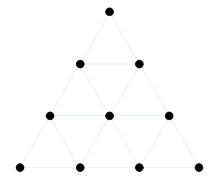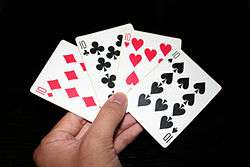10
10 (ten) is an even natural number following 9 and preceding 11. Ten is the base of the decimal numeral system, by far the most common system of denoting numbers in both spoken and written language. The reason for the choice of ten is assumed to be that humans have ten fingers (digits).
| ||||
|---|---|---|---|---|
[[{{#expr: (floor({{{number}}} div {{{factor}}})) * {{{factor}}}+({{{1}}}*{{{factor}}} div 10)}} (number)|{{#switch:{{{1}}}|-1={{#ifexpr:(floor({{{number}}} div 10)) = 0|-1|←}}|10=→|#default={{#expr:(floor({{{number}}} div {{{factor}}})) * {{{factor}}}+({{{1}}}*{{{factor}}} div 10)}}}}]] [[{{#expr: (floor({{{number}}} div {{{factor}}})) * {{{factor}}}+({{{1}}}*{{{factor}}} div 10)}} (number)|{{#switch:{{{1}}}|-1={{#ifexpr:(floor({{{number}}} div 10)) = 0|-1|←}}|10=→|#default={{#expr:(floor({{{number}}} div {{{factor}}})) * {{{factor}}}+({{{1}}}*{{{factor}}} div 10)}}}}]] [[{{#expr: (floor({{{number}}} div {{{factor}}})) * {{{factor}}}+({{{1}}}*{{{factor}}} div 10)}} (number)|{{#switch:{{{1}}}|-1={{#ifexpr:(floor({{{number}}} div 10)) = 0|-1|←}}|10=→|#default={{#expr:(floor({{{number}}} div {{{factor}}})) * {{{factor}}}+({{{1}}}*{{{factor}}} div 10)}}}}]] [[{{#expr: (floor({{{number}}} div {{{factor}}})) * {{{factor}}}+({{{1}}}*{{{factor}}} div 10)}} (number)|{{#switch:{{{1}}}|-1={{#ifexpr:(floor({{{number}}} div 10)) = 0|-1|←}}|10=→|#default={{#expr:(floor({{{number}}} div {{{factor}}})) * {{{factor}}}+({{{1}}}*{{{factor}}} div 10)}}}}]] [[{{#expr: (floor({{{number}}} div {{{factor}}})) * {{{factor}}}+({{{1}}}*{{{factor}}} div 10)}} (number)|{{#switch:{{{1}}}|-1={{#ifexpr:(floor({{{number}}} div 10)) = 0|-1|←}}|10=→|#default={{#expr:(floor({{{number}}} div {{{factor}}})) * {{{factor}}}+({{{1}}}*{{{factor}}} div 10)}}}}]] [[{{#expr: (floor({{{number}}} div {{{factor}}})) * {{{factor}}}+({{{1}}}*{{{factor}}} div 10)}} (number)|{{#switch:{{{1}}}|-1={{#ifexpr:(floor({{{number}}} div 10)) = 0|-1|←}}|10=→|#default={{#expr:(floor({{{number}}} div {{{factor}}})) * {{{factor}}}+({{{1}}}*{{{factor}}} div 10)}}}}]] [[{{#expr: (floor({{{number}}} div {{{factor}}})) * {{{factor}}}+({{{1}}}*{{{factor}}} div 10)}} (number)|{{#switch:{{{1}}}|-1={{#ifexpr:(floor({{{number}}} div 10)) = 0|-1|←}}|10=→|#default={{#expr:(floor({{{number}}} div {{{factor}}})) * {{{factor}}}+({{{1}}}*{{{factor}}} div 10)}}}}]] [[{{#expr: (floor({{{number}}} div {{{factor}}})) * {{{factor}}}+({{{1}}}*{{{factor}}} div 10)}} (number)|{{#switch:{{{1}}}|-1={{#ifexpr:(floor({{{number}}} div 10)) = 0|-1|←}}|10=→|#default={{#expr:(floor({{{number}}} div {{{factor}}})) * {{{factor}}}+({{{1}}}*{{{factor}}} div 10)}}}}]] [[{{#expr: (floor({{{number}}} div {{{factor}}})) * {{{factor}}}+({{{1}}}*{{{factor}}} div 10)}} (number)|{{#switch:{{{1}}}|-1={{#ifexpr:(floor({{{number}}} div 10)) = 0|-1|←}}|10=→|#default={{#expr:(floor({{{number}}} div {{{factor}}})) * {{{factor}}}+({{{1}}}*{{{factor}}} div 10)}}}}]] [[{{#expr: (floor({{{number}}} div {{{factor}}})) * {{{factor}}}+({{{1}}}*{{{factor}}} div 10)}} (number)|{{#switch:{{{1}}}|-1={{#ifexpr:(floor({{{number}}} div 10)) = 0|-1|←}}|10=→|#default={{#expr:(floor({{{number}}} div {{{factor}}})) * {{{factor}}}+({{{1}}}*{{{factor}}} div 10)}}}}]] [[{{#expr: (floor({{{number}}} div {{{factor}}})) * {{{factor}}}+({{{1}}}*{{{factor}}} div 10)}} (number)|{{#switch:{{{1}}}|-1={{#ifexpr:(floor({{{number}}} div 10)) = 0|-1|←}}|10=→|#default={{#expr:(floor({{{number}}} div {{{factor}}})) * {{{factor}}}+({{{1}}}*{{{factor}}} div 10)}}}}]] [[{{#expr: (floor({{{number}}} div {{{factor}}})) * {{{factor}}}+({{{1}}}*{{{factor}}} div 10)}} (number)|{{#switch:{{{1}}}|-1={{#ifexpr:(floor({{{number}}} div 10)) = 0|-1|←}}|10=→|#default={{#expr:(floor({{{number}}} div {{{factor}}})) * {{{factor}}}+({{{1}}}*{{{factor}}} div 10)}}}}]] List of numbers — Integers | ||||
| Cardinal | ten | |||
| Ordinal | 10th (tenth) | |||
| Numeral system | decimal | |||
| Factorization | 2 × 5 | |||
| Divisors | 1, 2, 5, 10 | |||
| Greek numeral | Ι´ | |||
| Roman numeral | X | |||
| Roman numeral (unicode) | X, x | |||
| Greek prefix | deca-/deka- | |||
| Latin prefix | deci- | |||
| Binary | 10102 | |||
| Ternary | 1013 | |||
| Quaternary | 224 | |||
| Quinary | 205 | |||
| Senary | 146 | |||
| Octal | 128 | |||
| Duodecimal | A12 | |||
| Hexadecimal | A16 | |||
| Vigesimal | A20 | |||
| Base 36 | A36 | |||
| Chinese numeral | 十,拾 | |||
| Hebrew | י (Yod) | |||
| Khmer | ១០ | |||
| Korean | 십 | |||
| Tamil | ௰ | |||
| Thai | ๑๐ | |||
| Devanāgarī | १० | |||
| Bengali | ১০ | |||
| Arabic & Kurdish | ١٠ | |||
Anthropology
Usage and terms
- A collection of ten items (most often ten years) is called a decade.
- The ordinal adjective is decimal; the distributive adjective is denary.
- Increasing a quantity by one order of magnitude is most widely understood to mean multiplying the quantity by ten.
- To reduce something by one tenth is to decimate. (In ancient Rome, the killing of one in ten soldiers in a cohort was the punishment for cowardice or mutiny; or, one-tenth of the able-bodied men in a village as a form of retribution, thus causing a labor shortage and threat of starvation in agrarian societies.)
- Ten is used as a theoretical highest number in topics that require a rating ("a mark out of ten"), by contrast having 0 or 1 as the lowest number, and 5 being average.
Other
- The number of kingdoms in Five Dynasties and Ten Kingdoms period.
- The house number of 10 Downing Street.
- The number of Provinces in Canada.
- Number of dots in a tetractys.
- The number of the French department Aube.
- The number of regions in Ghana.
- The number in tarot decks that corresponds to either Chance, Fortune, or the Wheel of Fortune, depending on the deck variant.
In mathematics
- Ten is a composite number with 4 divisors, its proper divisors being 1, 2 and 5. Ten is the smallest noncototient, a number that cannot be expressed as the difference between any integer and the total number of coprimes below it.[1]
- Ten is the second discrete semiprime (2 × 5) and the second member of the (2 × q) discrete semiprime family. Ten has an aliquot sum σ(n) of 8 and is accordingly the first discrete semiprime to be in deficit. All subsequent discrete semiprimes are in deficit. The aliquot sequence for 10 comprises five members (10,8,7,1,0) with this number being the second composite member of the 7-aliquot tree.
- Ten is the smallest semiprime that is the sum of all the distinct prime numbers from its lower factor through its higher factor (10 = 2 + 3 + 5 = 2 . 5) Only three other small semiprimes (39, 155, and 371) share this attribute.
- Ten is a semi-meandric number.
- Ten is the sum of the first three prime numbers, of the four first positive integers (1 + 2 + 3 + 4), of the square of the two first odd numbers and also of the first four factorials (0! + 1! + 2! + 3!). Ten is the eighth Perrin number, preceded in the sequence by 5, 5, 7.
- A polygon with ten sides is a decagon, and 10 is a decagonal number.[2] Because 10 is the product of a power of 2 (namely 21) with nothing but distinct Fermat primes (specifically 5), a regular decagon is a constructible polygon.
- Ten is also a triangular number, a centered triangular number,[3] and a tetrahedral number.[4]
- Ten is the number of n queens problem solutions for n = 5.
- Ten is the smallest number whose status as a possible friendly number is unknown.
- Ten factorial seconds is exactly equal to 6 weeks.
- According to a conjecture, ten is the average sum of the proper divisors of the natural numbers if the size of the numbers approaches infinity (sequence A297575 in the OEIS).
- Ten is the smallest number whose fourth power can be written as a sum of two squares in two different ways. (802 + 602 and 962 + 282)
In numeral systems
Decimal system
As is the case for any base in its system, ten is the first two-digit number in decimal and thus the lowest number where the position of a numeral affects its value. Any integer written in the decimal system can be multiplied by ten by adding a zero to the end (e.g. 855 × 10 = 8550).
Roman numerals
The Roman numeral for ten is X (which looks like two Vs [the Roman numeral for 5] put together); it is thought that the V for five is derived from an open hand (five digits displayed), and X for ten from both hands. Incidentally, the Chinese word numeral for ten, is also a cross: 十.
Positional numeral systems other than decimal
The digit '1' followed by '0' is how the value of p is written in base p. (E.g. 16 in hexadecimal is 10.)
| Base | Numeral system | Number |
|---|---|---|
| 1 | unary | ********** |
| 2 | binary | 1010 |
| 3 | ternary | 101 |
| 4 | quaternary | 22 |
| 5 | quinary | 20 |
| 6 | senary | 14 |
| 7 | septenary | 13 |
| 8 | octal | 12 |
| 9 | novenary | 11 |
| 10 | decimal | 10 |
| 12 | duodecimal | X |
| 16 | hexadecimal | A |
List of basic calculations
| Multiplication | 1 | 2 | 3 | 4 | 5 | 6 | 7 | 8 | 9 | 10 | 11 | 12 | 13 | 14 | 15 | 16 | 17 | 18 | 19 | 20 | 21 | 22 | 25 | 50 | 100 | 1000 | |||
|---|---|---|---|---|---|---|---|---|---|---|---|---|---|---|---|---|---|---|---|---|---|---|---|---|---|---|---|---|---|
| 10 × x | 10 | 20 | 30 | 40 | 50 | 60 | 70 | 80 | 90 | 100 | 110 | 120 | 130 | 140 | 150 | 160 | 170 | 180 | 190 | 200 | 210 | 220 | 250 | 500 | 1000 | 10000 |
| Division | 1 | 2 | 3 | 4 | 5 | 6 | 7 | 8 | 9 | 10 | 11 | 12 | 13 | 14 | 15 | |
|---|---|---|---|---|---|---|---|---|---|---|---|---|---|---|---|---|
| 10 ÷ x | 10 | 5 | 3.3 | 2.5 | 2 | 1.6 | 1.428571 | 1.25 | 1.1 | 1 | 0.90 | 0.83 | 0.769230 | 0.714285 | 0.6 | |
| x ÷ 10 | 0.1 | 0.2 | 0.3 | 0.4 | 0.5 | 0.6 | 0.7 | 0.8 | 0.9 | 1 | 1.1 | 1.2 | 1.3 | 1.4 | 1.5 |
| Exponentiation | 1 | 2 | 3 | 4 | 5 | 6 | 7 | 8 | 9 | 10 |
|---|---|---|---|---|---|---|---|---|---|---|
| 10x | 10 | 100 | 1000 | 10000 | 100000 | 1000000 | 10000000 | 100000000 | 1000000000 | 10000000000 |
| x10 | 1 | 1024 | 59049 | 1048576 | 9765625 | 60466176 | 282475249 | 1073741824 | 3486784401 | 10000000000 |
In science
The SI prefix for 10 is "deca-".
The meaning "10" is part of the following terms:
- decapoda, an order of crustaceans with ten feet.
- decane, a hydrocarbon with 10 carbon atoms.
Also, the number 10 plays a role in the following:
- The atomic number of neon.
- The number of hydrogen atoms in butane, a hydrocarbon.
- The number of spacetime dimensions in some superstring theories.
The metric system is based on the number 10, so converting units is done by adding or removing zeros (e.g. 1 centimeter = 10 millimeters, 1 decimeter = 10 centimeters, 1 meter = 100 centimeters, 1 dekameter = 10 meters, 1 kilometer = 1,000 meters).
Astronomy
- The New General Catalogue object NGC 10, a magnitude 12.5 spiral galaxy in the constellation Sculptor.
- Messier object M10, a magnitude 6.4 globular cluster in the constellation Ophiuchus.
In religion and philosophy

- References in the Bible, Judaism and Christianity:
- The Ten Commandments of Exodus[5] and Deuteronomy[6] are considered a cornerstone of Judaism and Christianity.
- People traditionally tithed one-tenth of their produce. The practice of tithing is still common in Christian churches today, though it is disputed in some circles as to whether or not it is required of Christians.
- In Deuteronomy 26:12, the Torah commands Jews to give one-tenth of their produce to the poor (Maaser Ani). From this verse and from an earlier verse (Deut. 14:22) there derives a practice for Jews to give one-tenth of all earnings to the poor.[7]
- Ten Plagues were inflicted on Egypt in Exodus 7-12.
- Jews observe the annual Ten Days of Repentance beginning on Rosh Hashanah and ending on Yom Kippur.
- In Jewish liturgy, Ten Martyrs are singled out as a group.
- There are said to be Ten Lost Tribes of Israel (those other than Judah and Benjamin).
- There are Ten Sephirot in the Kabbalistic Tree of Life.
- In Judaism, ten men are the required quorum, called a minyan, for prayer services.
- Interpretations of Genesis in Talmudic and Midrashic teachings suggest that on the first day, God drew forth ten primal elements from the abyss in order to construct all of Creation: Heaven (or Fire), Earth, Chaos, Void, Light, Darkness, Wind (or Spirit), Water, Day, and Night. See also Bereshit (parsha).
- Jesus tells the Parable of the Ten Virgins in Matthew 25:1-13.
- In Pythagoreanism, the number 10 played an important role and was symbolized by the tetractys.
- In Hinduism, Lord Vishnu appeared on the earth in 10 incarnations, popularly known as Dashaavathar.
- In Sikhism, there are ten human Gurus.
In money
Most countries issue coins and bills with a denomination of 10 (See e.g. 10 dollar note). Of these, the U.S. dime, with the value of ten cents, or one tenth of a dollar, derives its name from the meaning "one-tenth" − see Dime (United States coin)#Denomination history and etymology.
In music
- The interval of a major tenth is an octave plus a major third.
- The interval of a minor tenth is an octave plus a minor third.
- "Ten lords a-leaping" is the gift on the tenth day of Christmas in the carol "The Twelve Days of Christmas".
In sports and games
- Decathlon is a combined event in athletics consisting of ten track and field events.
- In association football, the number 10 is traditionally worn by the team's advanced playmaker. This use has led to "Number 10" becoming a synonym for the player in that particular role, even if he or she does not wear that number.[8]
- In gridiron football, a team has a limited number of downs to advance the ball ten yards or more from where it was on its last first down; doing this is referred to as gaining another first down.
- In auto racing, driving a car at ten-tenths is driving as fast as possible, on the limit.
- In basketball, each quarter runs for 10 minutes under FIBA, WNBA, and NCAA women's rules.
- In blackjack, the Ten, Jack, Queen and King are all worth 10 points.
- In boxing, if the referee counts to 10 whether the boxer is unconscious or not, it will declare a winner by knockout.
- In cricket, a team's innings ends once it has lost 10 wickets.
- In men's field lacrosse, each team has 10 players on the field at any given time, except in penalty situations.
- In most rugby league competitions, the number 10 is worn by one of the two starting props. One exception to this rule is the Super League, which uses static squad numbering.
- In rugby union, the starting fly-half wears the 10 shirt.
- In ten-pin bowling, 10 pins are arranged in a triangular pattern and there are 10 frames per game.
In technology
- Ten-codes are commonly used on emergency service radio systems.
- Ten refers to the "meter band" on the radio spectrum between 28 and 29.7 MHz, used by amateur radio.
- ASCII and Unicode code point for line feed.
- In MIDI, Channel 10 is reserved for unpitched percussion instruments.
- In the Rich Text Format specification, all language codes for regional variants of the Spanish language are congruent to 10 mod 256.
- In macOS, the F10 function key tiles all the windows of the current application and grays the windows of other applications.
- The IP addresses in the range 10.0.0.0/8 (meaning the interval between 10.0.0.0 and 10.255.255.255) is reserved for use by private networks by RFC 1918.
In other fields

- Blake Edwards' 1979 movie 10.
- Series on HBO entitled 1st & Ten which aired between December 1984 and January 1991.
- Series on ESPN and ESPN2 entitled 1st and 10 which launched on ESPN in October 2003 to 2008 and moved to ESPN2 since 2008.
- In astrology, Capricorn is the 10th astrological sign of the Zodiac.
- In Chinese astrology, the 10 Heavenly Stems, refer to a cyclic number system that is used also for time reckoning.
- A 1977 short documentary film Powers of Ten depicts the relative scale of the Universe in factors of ten (orders of magnitude).
- CBS has a game show called Power of 10, where the player's prize goes up and down by either the previous or next power of ten.
- "Ten Chances" is one of the pricing games on The Price is Right.
- There are ten official inkblots in the Rorschach inkblot test.
- The traditional Snellen chart uses 10 different letters.
- Ten is an Australian television network. The Sydney member of the network has the three-letter call-sign TEN and used to broadcast in analogue on VHF Channel 10.
- Number Ten (also called Ella) is a character in the book series Lorien Legacies. The sixth book, The Fate of Ten, is named after her.
- A Cartoon Network franchise Ben 10, which has a number on its title.
See also

References
- "Sloane's A005278 : Noncototients". The On-Line Encyclopedia of Integer Sequences. OEIS Foundation. Retrieved 2016-06-01.
- "Sloane's A001107 : 10-gonal (or decagonal) numbers". The On-Line Encyclopedia of Integer Sequences. OEIS Foundation. Retrieved 2016-06-01.
- "Sloane's A005448 : Centered triangular numbers". The On-Line Encyclopedia of Integer Sequences. OEIS Foundation. Retrieved 2016-06-01.
- "Sloane's A000292 : Tetrahedral numbers". The On-Line Encyclopedia of Integer Sequences. OEIS Foundation. Retrieved 2016-06-01.
- Exodus 20:2-13
- Deuteronomy 5:6-17
- Archived February 23, 2006, at the Wayback Machine
- Khalil Garriot (21 June 2014). "Mystery solved: Why do the best soccer players wear No. 10?". Yahoo. Retrieved 19 May 2015.
External links
| Wikimedia Commons has media related to 10 (number). |
| Look up ten in Wiktionary, the free dictionary. |